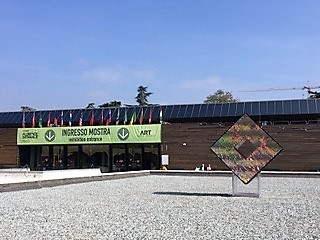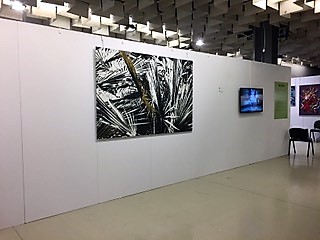
By Nona Debenham (Istituto Lorenzo de’ Medici)
The XIth Florence Biennale directed by Jacopo Celona and curated by Melanie Zefferino ran from October 6th through October 16th, 2017, and showed the works of over 450 artists coming from 72 countries and five continents. The event is a major contemporary art exhibition in Florence and is regarded as an outstanding showcase of the international contemporary artistic production. Every two years the Florence Biennale enlivens the Renaissance city with a program of events such as conferences, performances, workshops, and lectures.
The theme of this year’s Biennale is eARTh- Creativity & Sustainability and aimed to contribute to a future in which both creativity and sustainability inspired artists. For over two decades the Florence Biennale has attracted artists from around the world. The exhibition is not only attended by those that make art, but also by hundreds of people who teach, learn, promote, collect and enjoy art. Held at the Fortezza da Basso, the exhibition included digital art, Video Art, Photography, Installation Art, Performance Art as well as Painting, Drawing, Mixed Media, Sculpture, Ceramic Art, Textile & Fiber Art, and Jewelry Art.
During the XI edition of Florence Biennale, the International Exhibition of Contemporary Art in Florence, the “Lorenzo il Magnifico” prize was awarded to the career of Sauro Cavallini, a prominent Tuscan sculptur, who was recently featured inthe exhibition Intrusioni – Sauro Cavallini at the Civic Archaeological Museum in Fiesole (June 15th – October 15th). The event, born 20 years ago by Piero and Pasquale Celona, aims to outline a vision of the future in which creativity and sustainability are the founding principles of an ‘ecosystem’ of art and culture with a respect for nature and all life forms on Earth. The prize to Sauro Cavallini was awarded, “for masterfully infusing, through the art of sculpture, the life of form, giving the bronze and the rhythm of original figures as harmonious as the anatomies of extreme naturalness in their stylization” (Lorenzo il Magnifico Lifetime Achievement Award, Florence Biennale, 2017). The goal of the Florence Biennale is to give a global representation of contemporary art from established artists alongside figures emerging from around the world.
One of the emerging artists, also the featured artist of the show, is the up and coming Tim Bengel. A young German artist, known for his unique style of painting by using some rather uncommon materials, sand, gold, and glue. Using the technique of filling the sticky canvas with sand and gold, the artist transforms complex motifs into unique, minimalist, and expressive works. Beyond developing his own technique for making art, Bengel has a strong presence in social media, where some of his performance videos have reached over 250 million views. At the Biennale, the artist, for the majority of the exhibition only had one work on display accompanied by one of his viral videos playing on a loop for visitors to watch. During the weeklong show, Bengel worked on creating a new work, allowing visitors to gain inside access into his creative process. At the end of the week a new work, dedicated to Italian architecture, was revealed. This is typical of Bengel to have a live unveiling of his creations, leaving the sand on the work and flipping the canvas vertically, exposing the image underneath. Bengel’s art is unique and stands apart from his peers and more traditional art. He spoke at the Biennale about how for him art is about the creative process and about breaking traditions of what people think art is. The works of Bengel embody the creative process that the Biennale looks to support.
Besides hosting a featured artist like Tim Bengel, the Biennale hosted a multitude of artists. The range of art in the walls of the Fortezza da Basso is vast, ranging from fiber art to installations. The show also included the jewelry collection known as Quietude. Funded by the European Union and made by the research and innovation project H2020-Wear Sustain-2017, these accessories are made for women with various levels of hearing loss. The jewelry translates sounds into vibrations so that those who wear them are able to detect voices and sounds through the body. The pieces are truly works of art in themselves yet have a functional element to them. This type of display embodies what the Biennale XI is really about.
The show was a gathering place to see artists of all genre and walks of life coming together to promote not only their own personal creations but also the idea of art for a sustainable future. It was interesting to see how artists represented this theme. Some artists like took a more literal approach using earth-friendly renewable materials for their works, while others took a more theoretical approach using digital media to represent their ideas.
The XI Biennale is as interesting for the public as for the artists themselves, as it is a chance for everyone to make contacts from all over the world. The event allows the likes of artists, collectors, museum officials and the public to have dialogues about contemporary art and how it can influence sustainability and have an impact on the future earth.
For more information about the biennale and future events please go to this link.

Traduzione di Costanza Peruzzi (Università degli Studi di Firenze)
L’undicesima edizione di Florence Biennale, diretta da Jacopo Celona e curata da Melanie Zefferino, dal 6 al 16 Ottobre 2017, ha presentato i lavori di 450 artisti provenienti da 72 paesi di cinque continenti diversi. L’evento è la maggiore esposizione di arte contemporanea del capoluogo toscano, eccezionale vetrina della produzione artistica contemporanea. Ogni due anni la Florence Biennale rianima la città rinascimentale con un programma di eventi e conferenze, performances, workshops e letture.
Il tema della Biennale di quest’anno è stato eARTh-Creatività e Sostenibilità e mirava ad un futuro in cui creatività e sostenibilità, insieme, potranno ispirare gli artisti.
Per oltre due decadi la Florence Biennale ha attratto artisti da tutto il mondo. La mostra non è solo frequentata da coloro che fanno arte, ma da centinaia di persone che insegnano, imparano, promuovono, collezionano e amano l’arte.
Ospitata nei locali della Fortezza da Basso, l’esposizione ha dato spazio alla Digital Art, alla Video Art, alla fotografia, ad installazioni e performances, oltre che alla pittura, al disegno, alla scultura, all’arte plastica, alla gioielleria e Mixed Media.
In questa edizione, il premio alla carriera “Lorenzo il Magnifico” è stato riconosciuto allo scultore toscano Sauro Cavallini, le cui opere erano state recentemente esposte al Museo Archeologico di Fiesole, dal 15 Giugno al 15 Ottobre 2017, in occasione della mostra Intrusioni – Sauro Cavallini.
L’evento, nato venti anni fa da un progetto di Piero e Pasquale Celona, intendeva quest’anno illustrare un futuro in cui creatività e sostenibilità saranno i principi fondanti di un “ecosistema” di arte e cultura che rispetti la natura e tutte le forme di vita sulla terra. Il premio alla carriera è stato conferito a Cavallini “per aver magistralmente infuso, attraverso l’arte della scultura, vita alla forma, conferendo levità e movimento al bronzo di figure originali quanto armoniose che sono espressione di uno straordinario estro creativo” (Premio Lorenzo il Magnifico alla carriera, Florence Biennale, 2017).
Obiettivo della Biennale è quello di dare una rappresentazione globale dell’arte contemporanea dagli artisti affermati fino a quelli emergenti di tutto il mondo.
Uno degli artisti emergenti, nonchè artista ospite di quest’edizione, è stato il promettende Tim Bengel. Giovane artista tedesco, conosciuto per il suo stile unico di dipingere usando materiali fuori dal comune, sabbia, oro e colla. Coprendo la tela appiccicosa con sabbia e oro, l’artista trasforma complessi motivi in lavori unici, minimalisti e espressivi. Oltre allo sviluppo della sua personale tecnica artistica, Bengel ha una forte presenza sui social media, dove i video di alcune sue performances hanno ottenuto più di duecentocinquanta milioni di visualizzazioni. Qui alla Biennale, l’artista, per la maggior parte della mostra ha avuto esposto una sola opera accompagnata da uno dei suoi video virali riprodotto a ripetizione per il pubblico. Per l’intera settimana Bengel ha lavorato ad una nuova opera, consentendo ai visitatori di assistere al processo creativo. Al termine della Biennale, l’opera, dedicata all’architettura italiana, è state rivelata. La scoperta dell’opera dal vivo, come fosse una performance, è tipico del modus operandi dell’artista, che in questo caso ha lasciato la tela coperta di sabbia, e poi, issandola in verticale, ne ha disvelato l’immagine sottostante. L’opera di Bengel rimane unica nel suo genere, lontana dall’arte tradizionale. L’artista stesso spiega come l’arte sia per lui un processo creativo che rompe l’idea comune del fare arte e questa personale idea incarna in tutto e per tutto i principi di creatività ricercati in questa Biennale.
Oltre ad ospitare artisti quali Bengel, la Biennale ha accolto una moltitudine di altri artisti, spaziando dall’arte tessile alle installazioni. La mostra ha inoltre incluso la collezione di gioielleria conosciuta come Quietude, fondata dall’Unione Europea e sviluppata dal progetto di ricerca e innovazione H2020-Wear Sustain-2017, che propone accessori realizzati per donne con vari livelli di sordità. Questi gioielli traducono i suoni in vibrazioni di modo da permettere alle donne che li indossano di avvertire suoni e voci attraverso il corpo. I pezzi sono veri e propri capolavori artistici con in più la componente della funzionalità e come le suddette opere di Bengel incarnano a pieno il senso di questo evento.
Questa mostra è stata un luogo di incontro che ha visto artisti di ogni genere e cammino artistico uniti insieme per promuovere non solo la loro creazione personale ma anche un’idea di arte per un futuro sostenibile.interessante è stato vedere come gli artisti rappresentassero questo tema, alcuni avendo un approccio più letterale e utilizzando materiali ecosostenibili, altri con un approccio più teoretico usando media digitali per rappresentare la loro idea.
La XI Biennale è stata interessante sia per il pubblico che per gli artisti stessi, essendo per ognuno di loro un’opportunità per allacciare contatti con l’intero mondo dell’arte. L’evento ha permesso agli artisti, ai collezionisti, agli operatori museali e al pubblico di sviluppare un dialogo sull’arte contemporanea e su come questa potrà influire sulla sostenibilità e avere un impatto sul futuro della Terra.
Potete trovare ulteriori informazioni a questo link.